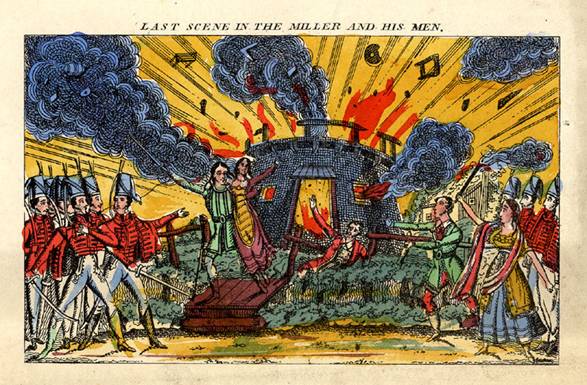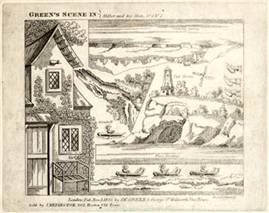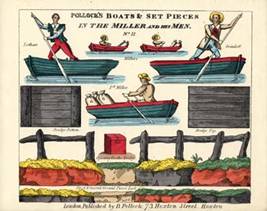The Miller and His Men 
This melodrama is the work of Isaac Pocock (2 March 1782 – 23 Aug 1835) an English dramatist and painter who wrote farces, melodramas and light operas, many of which he adapted for the stage from novels. The most successful of his more than forty works was Hit and Miss (1810), a musical farce. The Miller and His Men (1813) was also highly successful, and appears to have been regularly revived over the twenty years following its London premiere. That success was due mainly to the score by Henry Bishop, the composer of of over 120 stage works, including operas, light operas, cantatas, and ballets. Bishop is also the composer of "Home Sweet Home," which appeared first in John Howard Payne's American operetta Clari, or the Maid of Milan (1823), and which Bishop later promoted as a parlor song. This part of the Romantic Music website has been contributed by Christina Fuhrmann, and includes the music by Bishop for The Miller and His Men, which offers a rare glimpse at “melodramatic music,” or brief passages of instrumental music that coordinated with stage action. While many libretti of the time include indications for “music,” few published scores contain it. Sir Henry Bishop’s score features 25 melodramatic music cues, as well as an overture and four vocal numbers.
Credits:
Choral Director : Dr. Rowland Blackley
Singers :
- Jordan Black
- Bret O. Cowden
- Christopher L. Goffos
- Don R. Haught
- Derek Wayne Jackenheimer
- Jacob Poiner
- Johanna Regan
- Caleb Andrew Stout
- Katie Vargo
Piano : Dr. Christina Fuhrmann
Assistance with recording : Jake Lange, Dr. Thomas Reed
OVERTURE
Section 1: Adagio maestoso
Note: Like many overtures of the time, this is grand, with impressive flourishes. Its somber tone overall foreshadows the serious nature of the story.
Section 2: Allegro molto con spirito
Note: This section, fast and jaunty, may seem to herald a happy tale, but the quick staccato notes and buoyant rhythm were actually common features of music for bandits in the nineteenth century.
Section 3: Arietta: Andantino
Note: This section is marked as “performed on the Patent Keyed Bugle,” an instrument that had been patented three years earlier. Bishop was the first to use it in a stage production, and also featured it in his score to Guy Mannering (1816).
Section 4: Walzer: Un poco vivace
Note: This section is marked as “adapted from a Bohemian air.”
ACT I Scene i
The Banks of a River—On the right a rocky Eminence, on which is a Windmill at work—Cottage in front. Sun-set. Music [introduction to Chorus No. 1] as the Scene opens. The Miller’s Men are seen in perspective, descending the eminence—cross the River in Boats, and land near the Cottage with their Sacks—Then sing the following Round.
Chorus No. 1: When the Wind Blows
When the wind blows,
When the Mill goes,
Our hearts are all light and merry;
When the wind drops,
When the Mill stops,
We drink and sing, hey down derry.
With the concluding symphony [postlude to Chorus No. 1] the Millers depart …
Note: The singers here are millers who turn out to be a band of robbers. In order to lull the audience into thinking that they are millers, Bishop uses traditional musical markers of the pastoral: F major; a 6/8 meter; and a simple, repetitive melody. The vocal entrances are in the form of a round or canon.
Music [Melodramatic Music No. 1] The Miller appears in perspective coming from the Crag in the Rock. As the Boat disappears on the opposite side the two Robbers, Riber and Golotz, enter hastily, &c. …
Note : Note the distinct difference between the music for Grindoff, whom the audience is still supposed to imagine a miller, and Riber and Golotz, who are soon identified as robbers.
Music [Melodramatic Music No. 2] ([Riber and Golotz] retire as the Boat draws up to the Bank—the Miller [Grindoff] jumps ashore—Lothair at the same moment enters from the Cottage. …

ACT I Scene iii
Claudine and Laurett : Stay, prythee, stay
Claudine : The night is dark.
Claudine and Laurett : The cold wind whistles—Hark! hark! hark!
Stay, prythee, stay, the night is dark.
Karl : Pray come away.
Count Frederick : We must away.
Claudine, Laurett, Kreutz, and Kelmar : Stay, prythee, stay
Kreutz : The night is dark.
Claudine : The cold wind whistles—Hark! hark! hark!
Claudine, Laurett, Kreutz, and Kelmar : Stay, prythee, stay, the way is lone.
Count Frederick and Karl : We must away.
[Laurett ]: The ford is deep—the boat is gone.
Kelmar : And mountain torrents swell the flood,
And Robbers lurk within the wood.
Kreutz and Kelmar : And Robbers lurk within the wood.
Claudine, Laurett, Kreutz, and Kelmar :
Stay, prythee, stay, the night is dark, the way is lone.
Count Frederick and Karl : We must away.
All : Here (you/ we) must stay till morning bright,
Breaks through the dark and dismal night.
And merrily sings the rising Lark,
And hush’d the night bird—Hark! hark! hark!
Here (you/ we) must stay till morning bright,
Breaks through the dark and dismal night.
Here (you/ we) must stay.
ACT I Scene iv
Music . [Melodramatic Music No. 3] Enter Riber—Golotz follows; they look round cautiously—then advance to a particular rock which is nearly concealed by underwood and roots of trees.
Lothair : Hold! …
Music . [Melodramatic Music No. 4] Riber lets down a flat Stone in the Rock—Golotz leads Lothair to it—they enter, and he is drawn up.
ACT I Scene v
A Cavern. Banditti grouped—variously employed, chiefly carousing round a Table—on which are Flasks of Wine, &c. &c. …
Chorus No. 2: Fill Boys & Drink About
1st Robber : Fill, boys, and drink about,
Wine will banish sorrow.
Come drain the Goblet out
We’ll have more tomorrow.
Chorus : Fill, boys, and drink about,
Wine will banish sorrow
Come drain the Goblet out,
We’ll have more tomorrow.
Glee
We live free from fear
In harmony here
Combin’d, just like brother and brother.
And this be our toast,
The Freebooters boast,
Success and good will to each other!
Chorus : Fill, boys, and drink about,
Wine will banish sorrow
Come drain the Goblet out,
We’ll have more tomorrow.
Note : This classic drinking chorus features a major key, sprightly dotted rhythms, and a catchy tune, which invite the audience to join the robbers’ revelry even as we know we should repulse their wicked lifestyle.
A single note on the bugle is heard from below …
Music. [[Melodramatic Music No. 5 and [Melodramatic Music No. 6 ]The trap in the floor is thrown open, and Riber ascends, followed by Golotz and Lothair.
Robbers : Hail, to our new companion.
Ravina : A man!
… A bugle is heard above …
Music. [Melodramatic Music No. 7 ] Grindoff, in Robber’s apparel, descends the opening, advances, and seeing Lothair, starts. …
Note : The bugle referred to is most likely the keyed bugle mentioned in the overture, part 2, which played an important role throughout the drama. Notice that the music for Grindoff’s entrance is less that of a villain than that of a leader: full chords, dotted rhythms, and a triumphant ascending melody.
Grindoff then puts on his Miller’s frock, hat, &c. Riber advances, armed with pistols in his belt, a dark lanthorn, &c. and they retire up the opening as the Banditti sing the Chorus .
Chorus No. 3: [Now to the Forest We Repair]
Now to the Forest we repair
Awhile like spirits wander there.
In darkness we secure our prey
And vanish at the dawn of day.
Note: The lively dotted rhythms and catchy melodies of the introduction are typical of many musical depiction of robbers in the nineteenth century. Once the chorus enters, however, the key switches suddenly to minor before concluding with an energetic major key section.

ACT II Scene i
Music. [Melodramatic Music No. 8 ] The interior of Kelmar’s cottage as before. Frederick asleep in a Chair, reclining on a Table, beneath which and at the opposite Side near the Fire, Karl is seen likewise asleep. Frederick’s Sword lies on the Table. The Fire nearly extinguished. Enter Claudine with a lamp. …
Note : Although Claudine entered already in Act I, Bishop did not write entrance music for her until here. To paint Claudine’s pure, innocent femininity, Bishop uses tentative, staccato steps, complimented by a gentle, embellished line in the higher register.
Music. [Melodramatic Music No. 9 ] A dark lanthorn borne by Riber has appeared at the window; at this moment Riber half enters the room, but suddenly retires, observing a light occasioned by Karl’s stirring the fire with his dagger. …
Riber enters cautiously, holding forward the lanthorn; Grindoff follows. Riber on seeing Frederick draws a poniard. As he raises his arm, Grindoff catches it and prevents the blow.
Music appropriate. [Melodramatic Music No. 10]…
[Riber] looks at the priming of his pistol—then towards the table …
Riber advances hastily, and in the act of bringing his pistol to the level against Frederick, is stabbed by Karl, who has arisen and retreated behind the table to receive him; at the same instant Grindoff enters, and Frederick rushing from the chair at the noise of the pistol, seizes him by the collar, and Group stand amazed. Music . [Melodramatic Music No. 11 ]…
Note : Melodramatic Music Nos. 9-11 offer an especially fine example of music coordinating with action. Specific actions are written in the score, and the music clearly mimics the events onstage.
ACT II Scene ii
Music. [Melodramatic Music No. 12 ]Grindoff enters with Claudine in his arms, and is seen concealing her and himself in the Secret Rock; he lets down the flat stone and disappears as Frederick in haste enters. …
ACT II Scene iii
Music. [None found in score, but Melodramatic Music No. 13 may be used here] Robbers discovered asleep in different parts of the stage. Lothair as on guard, with a Carbine, stands beneath the Magazine …
Music. [Melodramatic Music No. 13 ] Lothair retires cautiously as he places his foot over the body of a Robber, who is seen asleep on the steps leading to the Magazine; by accident he touches the carbine which slips down; the Robber being disturbed alters his position while Lothair stands over him—but again reposes—Lothair advances up the steps. As he arrives at the magazine, Wolf’s signal is heard from above, the Robbers instantly start up, and Lothair at the same moment springs from the steps, and seizing his carbine stands in his previous attitude.
[Melodramatic Music No. 14] immediately Wolf is seen descending the opening on the right with Claudine senseless in his arms. …
Music. [Second Half of Melodramatic Music No. 14 repeated ]As Wolf, &c. go off, Lothair immediately runs up the steps to the Magazine, and places the fuze within, closes the door, and directs it towards the trap by which he first enter’d the cave. …
Note : It is intriguing that Bishop used the same basic musical material for Melodramatic Music Nos. 13 and 14, although one number is for the hero, the other for the villain. He may have wished to unify the scene musically, to demonstrate that a change in dynamics and register could produce a significantly different result, or perhaps to suggest the lurking danger of the robbers, quiet as they are sleeping, but loud as Wolf (Grindoff) enters.
Music. [Melodramatic Music No. 15 ] Claudine (Entering) ‘Tis he, ‘tis he, then I am safe. Ah! who are these, and in what dreadful place am I? …
Music . [Melodramatic Music No. 16 ]Lothair points to the Magazine; shews the train to Ravina, and explains his intention; then gives a phosphorous bottle which he shews the purpose of; she comprehends him. Claudine’s action, astonishment and terror. Lothair opens the trap.
[Lothair] Be careful be cautious, I implore you;—convey the train where I may distinctly see you from without the mill; and above all, let no anxiety of mind, no fear of failure, urge you to fire the train, till I give the signal.—Remember, Claudine might be the victim of such fatal indiscretion.
Ravina : But, Wolf.
(At this moment Wolf returns, and hearing his name halts at the back of the scene.
Lothair : Wolf with his guilty companions shall fall despised and execrated—Ah! remove the train (aside.
Wolf : Villain!
(Levels a pistol at Lothair, Ravina utters an exclamation of horror—Claudine retreats, and removes the train to the foot of the steps . …
Music. [Melodramatic Music No. 17] Ravina clasps her hands in entreaty, and descends the trap, which is closed violently by Wolf.
Wolf : Now, Spiller, follow me.
(Wolf takes his broad Miller’s hat which had caused his return, and Exit. Lothair following, and looking back significantly at Claudine, who then advances, cautiously opens the trap, gives the train to Ravina—and Exit to the side to where she was first conducted.
Music. [Melodramatic Music No. 18 ] appropriate during this.
ACT II Scene iv
Music heard within the Flask [a tavern. No Melodramatic Music in the score correlates to this]. …
With a violent effort of strength, the old man suddenly turns upon the Miller, and tears open his vest, beneath which he appears armed. Grindoff, at the same instant, dashes Kelmar from him, who impelled forward is caught by Frederick. Frederick draws his sword, Wolf draws pistols in each hand from side-pockets, his hat falling off at the same instant. Appropriate music [Melodramatic Music No. 19]…
Music. [Melodramatic Music No. 20 ] [Karl] throws down the poniard and catching Frederick’s sword, hastens after Wolf. The report of a pistol is immediately heard. …
Exit Fred. and Kelmar.
Music. [Melodramatic Music No. 21] At the same moment Golotz, followed by Lothair, bursts from the house. …
ACT II Scene the last [v]
Discovers a near view of the Mill standing on an elevated projection, from the foreground a narrow bridge passes to the rocky Promontory across the Ravine.—
Music. [Melodramatic Music No. 22 ]—Ravina appears ascending the gully with the fuze, which she places carefully in the crannies of the rock. …
Music. [Melodramatic Music No. 23 ] ([Ravina] retires. Grindoff enters as pursued, and turning, fires his remaining pistol; then hurries across the bridge, which he instantly turns in the manner of a canal bridge; Karl, following. …
Music. [Melodramatic Music No. 24 ] Lothair throws aside the cloak, and his natural complexion is seen; he throws himself before Claudine, and receives Grindoff’s attack; the robber is wounded, and staggers back, sounds his bugle, and the Mill is crowded with banditti. Lothair, having caught Claudine in his arms, (and previously thrown back the bridge upon his release from Grindoff,) hurries across it and as he is on it, cries “Now, Ravina, now, fire the train!”
Music. [Melodramatic Music No. 25 ] Ravina instantly sets fire to the fuze, the flash of which is seen to run down the side of the rock into the gully under the bridge from which she has ascended, and the explosion immediately takes place. Kelmar rushing forward, catches Claudine in his arms, and the whole form a group as the curtain descends.
Note : Both Melodramatic Music Nos. 24 and 25 add to the excitement of the final scene. In No. 24, when hero and villain fight, Bishop wrote brief bursts of sound, separated by rests, followed by a steady stream of staccato chords, which must have coincided with specific movements and blows. At the end, when Grindoff is wounded, Bishop uses a deceptive cadence, or a series of chords in which the last is unexpected, to highlight Grindoff’s defeat; surely the deceptive chord occurred precisely at the time when the hero dealt the decisive blow. And although No. 25 contains no stage directions, it clearly is meant to mimic the gradual burning of the fuse and the final explosion. A quiet, murmuring line begins, arpeggiating a chord at a higher and higher range, which paints the gradual progress of the fire. Cleverly, this chord turns out not to be the main chord of the home key, but rather a kind of distant cousin to the home key. Once we know what the real key is, we must wait through a few more measures of agitated arpeggios, perhaps as the fuse reaches closer and closer to its goal. A massive outpouring of sound is heard as the true home key is reached, which must have coincided with the explosion; one imagines that the previous portion could have been repeated if necessary to ensure this coordination. A long section of concluding chords follows as the audience appreciates the relief and triumph of the final tableau.
This not-for-profit site is intended to make vocal music and lyrics of the of the early 19th century in the British Isles, Europe, Canada, the United States, and Australia more accessible. It includes contemporary music of the period and later settings (e.g., Brian Holmes's complete score for Death's Jest Book and Lori Lange's settings of Byron lyrics). For further information, contact Paul.Douglass@sjsu.edu